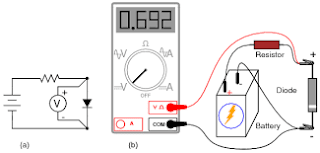Diode
A diode is a device which only allows unidirectional flow from positive direction to negative direction.
A diode only blocks current in the reverse direction while the reverse voltage is within a limited range otherwise reverse barrier breaks and the voltage at which this breakdown occurs is called reverse breakdown voltage. The diode acts as a valve in the electronic and electrical circuit. A P-N junction is the simplest form of the diode which behaves as ideally short circuit when it is in forward biased and behaves as ideally open circuit when it is in the reverse biased. Beside simple PN junction diodes, there are different types of diodes although the fundamental principle is more or less same. So a particular arrangement of diodes can convert AC to pulsating DC, and hence, it is sometimes also called as a rectifier. The name diode is derived from "di-ode" which means a device having two electrodes. Its also used to convert from AC to DC current.
Types of Diode
The types of diode are as follow-- Zener diode
- P-N junction diode
- Tunnel diode
- Varractor diode
- Schottky diode
- Photo diode
- PIN diode
- Laser diode
- Avalanche diode
- Light emitting diode
Simple circuit for diode:
how to check that the diode is working or not:
- Using multimeter we can check the diode
- if the multimeter display any value then the diode is working condition
- and some thersold values are there to check the diode is working properly or not
- below picture shows that how to check the diode


Very nice blog i have also write an article do checkout that too, PN Junction Diode(s)
ReplyDelete